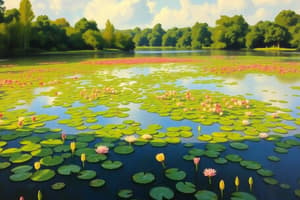Podcast
Questions and Answers
What does the environment consist of?
What does the environment consist of?
- Non-living (abiotic) things only
- Living (biotic) things only
- Both non-living and living things (correct)
- Neither non-living nor living things
The scope of the environment includes only natural resources.
The scope of the environment includes only natural resources.
False (B)
Who defined the environment as the sum total of those effective conditions in which organisms live?
Who defined the environment as the sum total of those effective conditions in which organisms live?
Tansley
______ is the hydrological cycle in the environment.
______ is the hydrological cycle in the environment.
What are the two main components of the environment?
What are the two main components of the environment?
Which statement is true about large countries?
Which statement is true about large countries?
The mineral resources are evenly distributed across the earth.
The mineral resources are evenly distributed across the earth.
What is the primary cause of cyclones?
What is the primary cause of cyclones?
The two types of climate disasters mentioned are floods and ______.
The two types of climate disasters mentioned are floods and ______.
Match the following types of vegetation with their respective environments:
Match the following types of vegetation with their respective environments:
What are the three elements that make up soil?
What are the three elements that make up soil?
Study Notes
Environment and Ecosystem
- Environment encompasses both living (biotic) and non-living (abiotic) components surrounding organisms.
- Definition by Tansley (1926): Sum total of conditions affecting the life of organisms, including air, water, solar radiation, minerals, and vegetation.
Solar System
- Earth is located approximately 150 million kilometers from the Sun.
- Temperature variations among planets influence their capacity to support life.
Environmental Interdependence
- Essential gases: Oxygen (O2) and Carbon Dioxide (CO2) exemplify interdependence in ecosystems.
- Perfect coordination between biotic and abiotic elements is crucial for ecological balance.
Environment - Totality
- Concept includes both living (biotic) and non-living (abiotic) elements, highlighting man's relationship with nature.
Environment - Cyclic Changes and Balance
- Air pressure fluctuations lead to phenomena like cyclones.
- Water cycles through the hydrological cycle, contributing to ecosystem sustainability.
- Temperature influences global heat balance impacting species distribution.
- Population dynamics and natural checks, such as the COVID-19 pandemic, underscore ecological balance.
Environmental Scope
- Vast and inclusive, covering natural resources, ecology, biodiversity, human activities, and environmental issues like pollution and global warming.
- Collective responsibility: Each individual affects and is influenced by the environment.
Environmental Components
- Natural components consist of abiotic elements (location, climate, minerals) and biotic elements (vegetation, animals).
- Human components including economic activities also shape the environment.
Location
- Absolute location defined by latitude and longitude.
- Relative location involves context-based geography, such as break-of-bulk points.
Topography
- Plains: Favorable for settlements and agriculture; home to 90% of the global population.
- Mountains: Less accessible, hindering development and population density.
Climate
- Influences disasters (floods, cyclones) as well as human physical capabilities and economic activities.
- Climate affects soil and vegetation types, which in turn shape biodiversity.
Resources and Country Size
- Larger countries can access a wider range of resources and have diverse climates; examples include the USA, Russia, China, India.
- Smaller countries often rely on exports for survival; e.g., Japan and the UK.
Shape and Coastline of Countries
- Country shapes: Compact, fragmented, or elongated, affecting accessibility and resource distribution.
- Coastline types can be smooth or broken, impacting economic activities, particularly in trade.
Minerals and Resource Distribution
- Resources are unevenly distributed; coal primarily found in the USA and Western Europe, while crude oil reserves are concentrated in the USA and the Middle East.
Soil Composition
- Soil consists of disintegrated rock particles, organic matter (humus), and microorganisms aiding decomposition, making it a critical biotic resource.
Human or Cultural Environment
- Man modifies the natural environment through technological advancements to meet social, economic, and political needs, resulting in a human or cultural environment.
Studying That Suits You
Use AI to generate personalized quizzes and flashcards to suit your learning preferences.
Related Documents
Description
Explore the intricate relationships within ecosystems and the vital role of the environment. This quiz examines concepts such as interdependence, cyclic changes, and the importance of air and water for sustaining life. Test your knowledge on the fundamental principles of our planet and its ecological systems.




